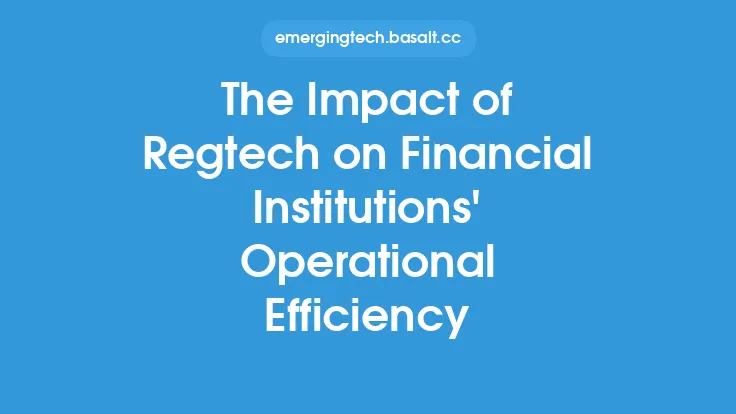The rise of digital payments has transformed the financial landscape, enabling fast, secure, and convenient transactions. At the heart of this transformation are financial institutions, which have had to adapt to the changing landscape by collaborating with digital payment providers or developing their own digital payment solutions. This collaboration and competition between digital payments and financial institutions have given rise to new business models, products, and services that are changing the way we think about money and financial transactions.
Introduction to Digital Payments and Financial Institutions
Digital payments refer to the electronic transfer of funds from one party to another, using digital channels such as online banking, mobile wallets, and payment cards. Financial institutions, on the other hand, are organizations that provide financial services to customers, including banks, credit unions, and other types of lenders. The intersection of digital payments and financial institutions has created new opportunities for innovation and growth, as well as challenges and risks that must be managed.
Collaboration between Digital Payments and Financial Institutions
Collaboration between digital payments and financial institutions has taken many forms, including partnerships, joint ventures, and acquisitions. For example, many banks have partnered with digital payment providers such as PayPal and Apple Pay to offer their customers a range of digital payment options. These partnerships have enabled banks to expand their reach and offer new services to their customers, while also providing digital payment providers with access to a broader customer base.
Competition between Digital Payments and Financial Institutions
Despite the many collaborations between digital payments and financial institutions, there is also intense competition between these two sectors. Digital payment providers such as Stripe and Square have developed their own payment processing systems, which have disrupted the traditional payment processing models used by financial institutions. These new payment processing systems are often faster, cheaper, and more convenient than traditional models, which has put pressure on financial institutions to innovate and adapt.
Impact of Digital Payments on Financial Institutions
The rise of digital payments has had a significant impact on financial institutions, forcing them to rethink their business models and strategies. One of the main challenges facing financial institutions is the disintermediation of traditional payment processing systems, which has reduced their role in the payment process. To respond to this challenge, many financial institutions have invested heavily in digital payment technologies, such as mobile wallets and payment cards, to remain relevant and competitive.
Role of Regulation in Digital Payments and Financial Institutions
Regulation plays a critical role in the digital payments and financial institutions landscape, providing a framework for innovation and growth while also protecting consumers and maintaining financial stability. Regulatory bodies such as the Federal Reserve and the European Central Bank have issued guidelines and regulations governing digital payments, including rules on payment processing, data protection, and anti-money laundering. These regulations have helped to build trust and confidence in digital payments, while also providing a level playing field for financial institutions and digital payment providers to compete.
Technical Infrastructure of Digital Payments and Financial Institutions
The technical infrastructure of digital payments and financial institutions is complex and multifaceted, involving a range of technologies and systems. At the heart of this infrastructure are payment processing systems, which enable the electronic transfer of funds between parties. These systems typically involve a range of components, including payment gateways, payment processors, and acquiring banks. The payment gateway is the interface between the merchant and the payment processor, while the payment processor is responsible for routing the payment to the acquiring bank. The acquiring bank, in turn, is responsible for settling the payment with the merchant.
Security and Risk Management in Digital Payments and Financial Institutions
Security and risk management are critical components of the digital payments and financial institutions landscape, as they help to protect consumers and maintain financial stability. One of the main risks facing digital payments is cybercrime, which can take many forms, including hacking, phishing, and identity theft. To mitigate these risks, financial institutions and digital payment providers have invested heavily in security technologies, such as encryption, firewalls, and intrusion detection systems. They have also implemented robust risk management practices, including know-your-customer (KYC) and anti-money laundering (AML) rules, to prevent illicit activities.
Future of Digital Payments and Financial Institutions
The future of digital payments and financial institutions is likely to be shaped by a range of factors, including technological innovation, changing consumer behavior, and regulatory developments. One of the main trends driving the future of digital payments is the rise of emerging technologies, such as blockchain and artificial intelligence, which are enabling new forms of payment and financial innovation. Another trend is the growth of mobile payments, which are expected to become increasingly popular as more consumers use their mobile devices to make payments. As the digital payments landscape continues to evolve, financial institutions will need to adapt and innovate to remain relevant and competitive.
Conclusion
In conclusion, the collaboration and competition between digital payments and financial institutions have transformed the financial landscape, enabling fast, secure, and convenient transactions. As the digital payments landscape continues to evolve, financial institutions will need to adapt and innovate to remain relevant and competitive. By understanding the complex relationships between digital payments and financial institutions, we can better navigate the opportunities and challenges of this rapidly changing landscape. Whether through partnerships, investments, or innovation, financial institutions must be prepared to respond to the changing needs of consumers and the evolving digital payments landscape.





